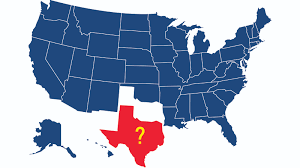by Martin Armstrong, Armstrong Economics:

The severity of the migrant crisis may be new to those who do not live on a bordering state. Yet Texas has been grappling with this issue for years, resulting in countless calls for a secession from the United States or “Texit.” How would Texas manage as an independent nation?
Size and Population
Texas would be the 39th largest nation by land mass. Texas encompasses 268,596 sq. miles, roughly the size of France, and is larger than many developed nations including the United Kingdom. Texas had an estimated population of 30,503,301 as of July 2023, making it the second-most populous state in the United States after California. Texas would be the 50st most populous country in the world.
TRUTH LIVES on at https://sgtreport.tv/
Economy
Texas has the second-largest economy in the United States behind California. In 2023, the Texas economy exhibited a mix of trends. While the state’s economic growth slowed in Q4, with job growth falling sharply in October and business activity contracting slightly in November, the real GDP for Texas grew at an annual rate of 4.9% in Q2, outpacing the U.S. growth rate of 2.1%. Its real GDP stood at $2.5 trillion in Q3 of 2023. Therefore, Texas is the world’s 8th largest economy.
For context, Russia’s economy was valued at $1.862 trillion in nominal terms and $5.056 trillion in PPP. Texas has a larger economy than Australia, Spain, Italy, and Mexico, to name a few.
Military Power
Texas alone boasts one of the best militaries in the world, with over 115,000 active duty troops. The Texas Military Forces, which include the Texas Army National Guard, Texas Air National Guard, and Texas State Guard, have a total size of 23,200 personnel and a budget of $1.851 billion as of 2023. In addition to the state forces, Texas is also home to about 70,000 U.S. Army personnel, 30,000 Air Force troops, and 8,000 Navy and Marines. Texas is home to 15 military bases and installations distributed across the state, with most of them clustered around San Antonio and Corpus Christi.
Texas has two nuclear power plants. The South Texas Project Electric Generating Station, located southwest of Bay City, Texas, has two Westinghouse Pressurized Water Reactors with a total capacity of 2,700 megawatts. The Comanche Peak Nuclear Power Plant, located south of Fort Worth, Texas, also has two reactors with a total capacity of 2,300 megawatts. These two plants combined have an installed capacity of more than 5,000 megawatts of electricity and contribute to about 10% of Texas’ total energy generation.
Infrastructure
While not always reliable, Texas has its own power grid, known as the Texas Interconnection. It is an alternating current (AC) power grid managed by the Electric Reliability Council of Texas (ERCOT), providing power to 90% of the state. Texas Interconnection is one of the three minor grids in the North American power transmission network, and the state has maintained as a separate grid for political reasons. The grid does not cross state lines and is not under federal regulation.
The state features more miles of public roads and freight rail than any other state, with 313,220 miles of public roads and 10,539 miles of freight rail. Additionally, Texas is home to the nation’s top airport for a number of domestic destinations. Texas has a total of 393 airports available for public use, making it the state with the highest number of airports in the United States.
Read More @ ArmstrongEconomics.com



